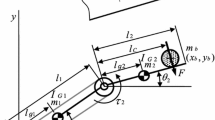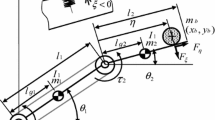Abstract
This paper demonstrates dynamic advantages of singular configurations for a two-link mechanism by theoretical analysis and numerical simulations. The advantages can be utilized in moving a heavy object by the mechanism. The theoretical analysis reveals that the configurations of the mechanism near the singular ones are advantageous in generating large acceleration of the object through the joint torques and the kinetic energy of the mechanism. We illustrate the advantages by numerical simulations for two typical motions, that is, a lifting motion of a two-link manipulator and a jumping motion of a two-link legged robot. It is shown that the joint torques necessary to achieve these motions are reduced to a large extent by using the advantages.
















Similar content being viewed by others
References
Marchand, E., Chaumette, F., Rizzo, A.: Using the task function approach to avoid robot joint limits and kinematic singularities in visual servoing. In: Proceedings of the IEEE/RSJ International Conference on Intelligent Robots and Systems, vol. 3, pp. 1083–1090 (1996)
Matsuno, F., Sato, H.: Trajectory tracking control of snake robots based on dynamic model. In: Proceedings of the IEEE International Conference on Robotics and Automation, pp. 3029–3034 (2005)
Kim, J., Marani, G., Chung, W.K., Yuh, J.: Task reconstruction method for real-time singularity avoidance for robotic manipulators. Adv. Robot. 20(4), 453–481 (2006)
Murray, R., Li, Z., Sastry, S.: A Mathematical Introduction to Robotic Manipulation. CRC Press, Boca Raton (1994)
Yim, M., Duff, D., Zhang, Y.: Closed-chain motion with large mechanical advantage. In: Proceedings of the IEEE/RSJ International Conference on Intelligent Robots and Systems, vol. 1, pp. 318–323 (2001)
Wang, C.-Y.E., Timoszyk, W.K., Bobrow, J.E.: Payload maximization for open chained manipulators: finding weightlifting motions for a Puma 762 robot. IEEE Trans. Robot. Autom. 17(2), 218–224 (2001)
Brown, K.L.: Design and analysis of robots that perform dynamic tasks using internal body motion. PhD Thesis, MIT (1994)
Rosenstein, M.T., Grupen, R.A.: Velocity-dependent dynamic manipulability. In: Proceedings of the IEEE International Conference on Robotics and Automation, vol. 3, pp. 2424–2429 (2002)
Kumar, V., Gardner, J.F.: Kinematics of redundantly actuated closed chains. IEEE Trans. Robot. Autom. 6(2), 269–274 (1990)
Urakubo, T., Mashimo, T., Kanade, T.: Efficient pulling motion of a two-link robot arm near singular configuration. In: Proceedings of the IEEE/RSJ International Conference on Intelligent Robots and Systems, pp. 1372–1377 (2010)
Urakubo, T., Mashimo, T., Kanade, T.: Optimal placement of a two-link manipulator for door opening. In: Proceedings of the IEEE/RSJ International Conference on Intelligent Robots and Systems, pp. 1446–1451 (2009)
Asada, H.: A geometrical representation of manipulator dynamics and its application to arm design. J. Dyn. Syst. Meas. Control 105(3), 131–142 (1983)
Yoshikawa, T.: Manipulability of robotic mechanisms. Int. J. Robot. Res. 4, 3–9 (1985)
Yoshikawa, T.: Dynamic manipulability of robot manipulators. In: Proceedings of the IEEE International Conference on Robotics and Automation, vol. 2, pp. 1033–1038 (1985)
Bowling, A., Kim, C.: Velocity effects on robotic manipulator dynamic performance. ASME J. Mech. Des. 128(6), 1236–1245 (2006)
Urakubo, T., Yoshioka, H., Mashimo, T., Wan, X.: Experimental study on efficient use of singular configuration in pulling heavy objects with two-link robot arm. In: Proceedings of the IEEE International Conference on Robotics and Automation, pp. 4582–4587 (2014)
Wan, X., Urakubo, T., Tada, Y.: Optimization of jumping motion of a legged robot for different take-off postures. J. Mech. Sci. Technol. 29(4), 1391–1397 (2015)
Wan, X., Urakubo, T., Tada, Y.: Landing motion of a legged robot with minimization of impact force and joint torque. J. Robot. Mechatron. 27(1), 32–40 (2015)
Bobrow, J.E.: Optimal robot plant planning using the minimum-time criterion. IEEE Trans. Robot. Autom. 4(4), 443–450 (1988)
Wan, X., Urakubo, T., Mashimo, T.: Generation of large pulling force by a mobile manipulator through singular configuration. In: Proceedings of the IEEE International Conference on Robotics and Biomimetics, pp. 408–414 (2015)
Chiaverini, S., Egeland, O.: A solution to the singularity problem for six-joint manipulators. In: Proceedings of the IEEE International Conference on Robotics and Automation, pp. 644–649 (1990)
Author information
Authors and Affiliations
Corresponding author
Appendices
Appendix A
The acceleration \({\boldsymbol{a}}_{t}\) corresponds to the dynamic manipulability ellipsoid with \(\dot{\boldsymbol{q}}=0\) and no gravity effect. In [14], the ellipsoid is defined by
and illustrates the relation between bounded joint torques and the end-effector acceleration caused from the torques. Fig. 17 shows the dynamic manipulability ellipsoids with different postures by using the physical parameters in Table 1.
In Fig. 17, the shape of the ellipsoid changes rapidly as the robot approaches its singular configurations. The maximum possible acceleration in \(y\)-axis firstly increases as the manipulator extends, and reaches the peak when the manipulator is almost extended. From then on, it intensely decreases to 0 in \(C_{0}\). A similar behavior of the maximum acceleration in \(x\)-axis can also be found near \(C_{\pi }\).
Appendix B
If (15) holds but \(\ddot{\theta }_{2}\neq -2\ddot{\theta } _{1}\) on the \(y\)-axis, the horizontal component of \(\boldsymbol{a}\) does not equal zero. Under the same assumptions as in Sect. 3, the horizontal components of \({\boldsymbol{a}}_{t}\), \({\boldsymbol{a}} _{g}\), and \({\boldsymbol{a}}_{v}\), that is, \(a_{tx}\), \(a_{gx}\), and \(a_{vx}\), are investigated.
2.1 B.1 Torque-dependent acceleration
When \(\theta_{1}\in [O(1/\sqrt{m_{w}}), \pi /2]\), \(a_{tx}\) is approximately calculated as
The absolute value of \(a_{tx}\), \(\vert a_{tx} \vert \), has a peak value at \(c=c^{*}\), where \(c=\cos (\theta_{1})\) and \(c^{*}=\sqrt{K_{1}}/(2l\sqrt{m _{w}})\ll 1\). According to (34), joint torques should satisfy the following relation to generate the maximum value of \(a_{tx}\):
We chose the joint torques that satisfy \(\Vert \boldsymbol{\tau } \Vert =15\) and (35), and drew the profiles of the actual value of \(a_{tx}\) from (18) and the approximate value of \(a_{tx}\) from (34) as shown in Fig. 18 with the physical parameters in Table 1. The drastic variation of \(a_{tx}\) near \(C_{\pi }\) corresponds to the drastic change in the shape of the dynamic manipulability ellipsoid.
2.2 B.2 Gravity-dependent acceleration
Substituting (25) into (19), \(a_{gx}\) can be approximately obtained for \(\theta_{1}\in [0,\pi /2]\) as
where \(K_{3}=m_{1}l_{g1}^{2}+m_{2}(l^{2}-l_{g2}^{2})+I_{1}-I_{2}=O(1)\). The acceleration \({a}_{gx}\) has one local maximum and one local minimum of \(O(1/\sqrt{m_{w}})\) near the singular configurations. Fig. 19 shows the profiles of the actual value of \(a_{gx}\) from (19) and the approximate value of \(a_{gx}\) from (36).
2.3 B.3 Velocity-dependent acceleration
Substituting (27) into (20), \(a_{vx}\) is approximated for \(\theta_{1}\in [0,\pi /2]\) as
The acceleration \(a_{vx}\) has a peak value of \(O(1/\sqrt{m_{w}})\) at \(s=\sqrt{K_{1}}/(2l\sqrt{2m_{w}})\). Fig. 20 shows the profiles of the actual value of \(a_{vx}\) from (20) and the approximate value of \(a_{vx}\) from (37).
It should be noted that, when \(l_{1} \neq l_{2}\), the approximate solution of \(a_{vx}\) is quite different from (37). A large \(a_{vx}\) of \((l_{1}-l_{2})O(1)\) is caused from the energy of \(O(1)\) in the singular configuration \(C_{\pi }\).
2.4 B.4 Total acceleration
From (17), (18), (19), and (20), we drew the profiles of the actual values of \(a_{tx}\), \(a_{gx}\), \(a_{vx}\), and \(a_{x}\) in Fig. 21 with the same physical parameters used for drawing Fig. 7. Comparing Figs. 7 and 21, we found that the maximum value of \(a_{vx}\) are much smaller than the one of \(a_{vy}\). When \(\Vert \boldsymbol{\tau } \Vert =O(1)\), the maximum value of \(a_{tx}\) near \(C_{\pi }\) is also smaller than the one of \(a_{ty}\) near \(C_{0}\). The peak value of \(\vert a_{gx} \vert \) is also small by comparing to the one of \(\vert a_{gy} \vert \).
Rights and permissions
About this article
Cite this article
Wan, X., Urakubo, T. & Tada, Y. Dynamic advantages of singular configurations in moving heavy object by a two-link mechanism. Multibody Syst Dyn 41, 149–172 (2017). https://doi.org/10.1007/s11044-016-9553-4
Received:
Accepted:
Published:
Issue Date:
DOI: https://doi.org/10.1007/s11044-016-9553-4









